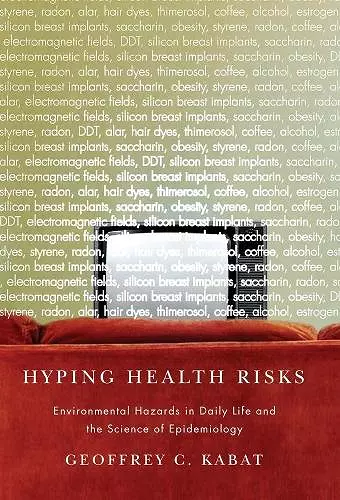Hyping Health Risks
Environmental Hazards in Daily Life and the Science of Epidemiology
Format:Hardback
Publisher:Columbia University Press
Published:18th Jul '08
Currently unavailable, and unfortunately no date known when it will be back

Hyping Health Risks provides a valuable counterpoint to the confusion and paranoia that seems to grow proportionate to the constant barrage of health risk studies. Examining four of the most persistent and controversial issues in public health, Kabat's lucid and well-written book gives the lay reader all the basic concepts and epidemiological tools she needs to understand the available evidence. His presentation allows us to better discriminate between what matters to our health and what matters to the 'hypers'-a wide array of stakeholders, some well-intentioned, some much less so. -- Ernest Drucker, Montefiore Medical Center/Albert Einstein College of Medicine
The media constantly bombard us with news of the health hazards that lurk in our everyday lives. But, many of these hazards, even some that provoke regulatory action, have been greatly overblown. This book examines the forces that contribute to health scares and economic, political, and psychological consequences of their "social amplification."The media constantly bombard us with news of health hazards lurking in our everyday lives, but many of these hazards turn out to have been greatly overblown. According to author and epidemiologist Geoffrey C. Kabat, this hyping of low-level environmental hazards leads to needless anxiety and confusion on the part of the public concerning which exposures have important effects on health and which are likely to have minimal or no effect. Kabat approaches health scares as "social facts" and shows that a variety of factors can contribute to the inflating of a hazard. These include skewed reporting by the media, but also, surprisingly, the actions of researchers who may emphasize certain findings while ignoring others; regulatory and health agencies eager to show their responsiveness to the health concerns of the public; and politicians and advocates with a stake in a particular outcome. By means of four case studies, Kabat demonstrates how a powerful confluence of interests can lead to overstating or distorting the scientific evidence. He considers the health risks of pollutants such as DDT as a cause of breast cancer, electromagnetic fields from power lines, radon within residences, and secondhand tobacco smoke. Tracing the trajectory of each of these hazards from its initial emergence to the present, Kabat shows how publication of more rigorous studies and critical assessments ultimately help put hazards in perspective.
The book can engage and enlighten regarding the complex context in which known and suspected health risks are identified, explored, and acted on. -- Barbara Gastel, M.D., M.P.H The New England Journal of Medicine A strong, valuable corrective to public understanding of the debate of environmental hazards... Highly Recommended. CHOICE Reading and reflecting on the thesis of this book can only help epidemiologists be more aware of our place in society and thus be more effective contributors. -- David A. Savitz American Journal of Epidemiology With clarity and dispassion, Geoffrey C. Kabat challenges widespread beliefs that secondhand smoke, low levels of radon, and other ostensible environmental nemeses are certain killers. In making his case, Kabat draws extensively on scientific evidence while shunning rhetoric and political posturing. The result is an admirable search for scientific truth amid a sea of conflicting and often uninformed opinions. -- Leonard Cole, Rutgers University Geoffrey C. Kabat, a respected epidemiologist, provides an insider's account of how a number of ostensible health hazards have been blown out of proportion. While we face a daily barrage of health scares, Kabat cuts through the confusion and provides a lucid and rigorous rationale for rejecting much of the fear culture that permeates our society. -- Shelly Ungar, University of Toronto This book does an exceptionally good job, first by putting epidemiology within the context of public health and then by explaining key terms, concepts, and methods. It provides a penetrating treatment of a difficult and complex subject in a readily understandable way. -- Steven D. Stellman, Mailman School of Public Health, Columbia University "Kabat, who wrote Hyping Health Risks--a fascinating and detailed examination of how we fell for certain, illusory environmental hazards--is possibly the only epidemiologist in the world to have also published a book on Dostoyevsky (he got a Ph.D in Russian and comparative literature from Columbia before switching tracks). And the background in literary analysis and theory adds a crucial ability to explain why we, as a society, are prone to turning hypothetical risks into "social facts." The upshot is that most public alarms about health risks dispense with the tools required to make sense of the alarm--and we end up with "disembodied findings" and ideology." -- Trevor Butterworth Forbes "Health scares come and go, but they often have a tenuous scientific basis. Kabat, a cancer epidemiologist, systematically rips through cancer alerts that overrode scientific rigor in recent decades. In so doing, he dispels the dubious science underlying the scares and explains how public confusion can come about. ... He extends his critique to debates linking radon gas exposure and secondhand cigarette smoke exposure to lung cancer. Those chapters will ruffle some feathers, but Kabat is unafraid of controversy." -- Nathan Seppa ScienceNews rich and valuable... -- Trevor Butterworth Forbes.com
- Winner of Choice Outstanding Academic Title 2009
ISBN: 9780231141482
Dimensions: unknown
Weight: unknown
272 pages